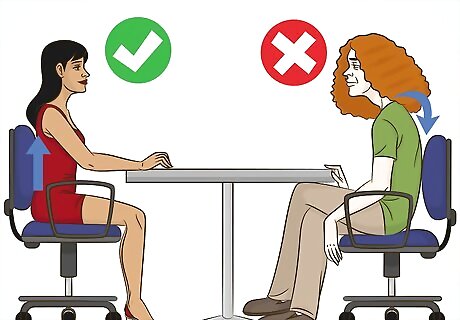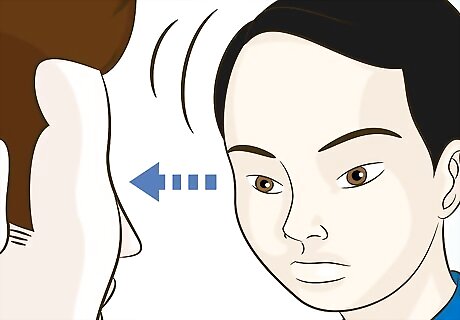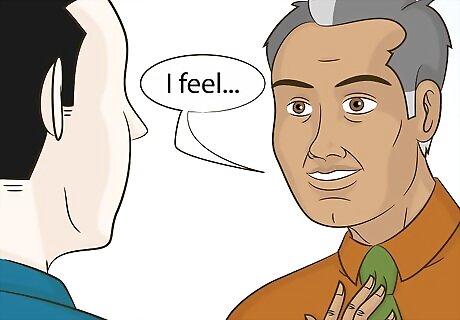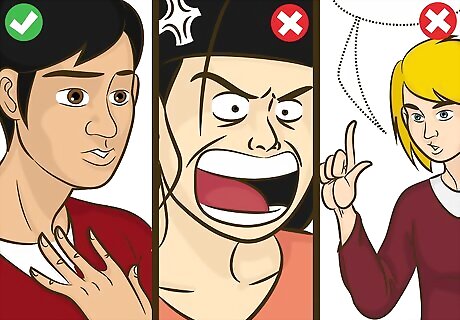
views
X
Research source
work,[2]
X
Research source
home,[3]
X
Trustworthy Source
Science Direct
Online archive of peer-reviewed research on scientific, technical and medical topics
Go to source
and in romantic relationships. By incorporating aspects of body language, behavior, speech, and appearance into your interpersonal interactions, you can increase self-confidence, gain self-respect, and improve your relationships with others.
Being Assertive Through Body Language and Behavior

Be assertive in your posture. You want to appear in control, poised, and confident without looking awkward or uncomfortable. Approach someone directly, rather than from the side of behind. Maintain enough distance so you can hear the person but are not in their face. Relax (do not slouch or hunch) your shoulders and spread your feet shoulder-width apart so your body weight is balanced evenly on both legs. Fold or clasp your hands and hold them in front of your stomach, no higher than your diaphragm.

Maintain an assertive posture when sitting. If you are addressing someone who is taller than you, suggest sitting down so you are at the same height. Find a table where you can sit and talk across from one another. Sit with your back straight. Your head should be upright and evenly balanced on your shoulders. Avoid tilting your head to one side or hunching your shoulders. Do not cross your legs. This can communicate that you are distracted or bored. Regularly crossing your legs when sitting may contribute to back pain or formation of spider veins. Clasp or fold your hands on the table. Having your hands in a location where the other person can see them to establish trust and demonstrate your sincerity.

Be aware how you use your hands and fingers. How you use your hands to communicate can set the tone for the rest of the conversation or interaction. When gesturing to make a point, keep your fingers together and point with an open palm. Avoid pointing or jabbing your finger at someone.

Be aware of your facial expressions. Look the other person in the eye and relax your face. Do not stare at the floor or look off to the side when speaking or listening. These will make you look nervous. Do not clench your jaw or tense the muscles in your face. Maintain direct eye contact, but avoid 'eye-balling' the other person.
Becoming a More Aggressive Communicator

Stand up for yourself and push back. Express your point of view or needs in a way that is clear and direct. You want to come off as aggressive, not disrespectful. Make sure you have someone's full attention before talking. Talk face-to-face, not to their back. Say their name when addressing them. Be honest with the person you are confronting, but remember to listen to their point of view as well.

Use words and phrases that are direct, but not judgmental. Sounding condescending, accusing, or overly aggressive can make a situation escalate. Words such as "always" or "never" tend to exaggerate statements and are good to avoid. Bring the conversation back to yourself. Use "I" instead of "you" statements, such as "I feel..." or "I don't like it when...". Follow these with facts.

Adjust the tone of your voice so it is even but firm. Shouting, whispering, or speaking with a shaky force will undermine anything you say. Speak at a level you would use for a normal conversation. Pleading or whining will make you sound desperate or emotionally dishonest. Speak in a clear, steady voice and do not hesitate. If you are preparing to confront someone, practice what you want to say in advance in front of a mirror.

Refuse someone. If you feel like someone is trying to take advantage of you or asking you to do something you feel is unreasonable (e.g. borrow money), do not feel guilty telling them "No". Follow these basic principles of saying "No": be brief, clear, firm, and honest. You can justify your response, but be brief and avoid excessive excuses. Do not start every sentence with "I'm sorry". Being overly apologetic will make you look immature or insincere. Reinforce your refusal with assertive body language. Maintain direct eye contact, hold your head up, keep your back straight, and relax your face and shoulders.
Channeling Your Aggression

Listen to music. Music can have the effect of stimulating emotional or physical arousal.Select a genre of music or songs that have a tempo of 80 to 130 beats per minute. Increase your heart rate by creating a playlist that organizes songs based on tempo, from slow (70-80 beats per minute) to fast (120-130 beats per minute). You can also alternate between fast and slow, loud or soft songs. Avoid music that triggers emotions such as anger or hostility.

Participate in sports. Physical exercise can help you develop discipline and self-control. Examples of sports that help reduce tension and positively channel aggression include: Martial arts, especially Tae Kwon Do and Kung Fu. Running or aerobics. Weight-lifting or boxing.

Meditate or relax. You can use relaxation techniques to prevent your aggression from developing into anger. Examples include: Take slow, deep breathes that come from your gut and not your chest. Repeat a word or phrase in your head such as "Relax" or "Calm down" while breathing deeply. Employ any of these techniques if you feel yourself getting tense or angry.

Confront overly aggressive or passive-aggressive behavior in others. If the source of your aggression or frustration is another person, you have a right to stand-up for yourself and be treated with respect. Use humor to counter hostile behavior or unfair treatment. Do not overreact. This will only lead to more drama and unnecessary aggression. Deal with controlling or manipulating personalities by following a negative statement with a question or asking them to clarify their position. This will keep you in charge of the conversation. Choose your battles. Ask yourself if the other person's behavior is hurting you or just annoying. Sometimes keeping your distance is the best option.
















Comments
0 comment